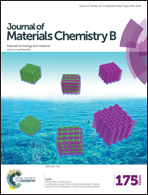A water-soluble two-photon fluorescence chemosensor for ratiometric imaging of mitochondrial viscosity in living cells†
Abstract
A convenient and rationally designed water-soluble two-photon excited fluorescence (TPEF) sensor for monitoring viscosity with specific targeting at the subcellular level remains a challenge. Herein, we reported a novel water-soluble ratiometric TPEF chemosensor EIN that is specifically responsive and singularly sensitive to mitochondria viscosity in living cells. Because its fluorescence emission bands at two different wavelengths show obvious enhancement with increased solvent viscosity, we found that the fluorescence intensity ratio (I569/I384) versus the logarithm of the viscosity (log η) enables monitoring and quantifying of abnormal changes of mitochondria viscosity. More importantly, EIN was successfully utilized to distinguish the normal and nystatin treated HepG2 cell viscosity difference of mitochondria. In a word, the merits of the NIR property, high selectivity and signal ratio provide a more convenient means for studying biological processes and mitochondria viscosity related diseases.


 Please wait while we load your content...
Please wait while we load your content...